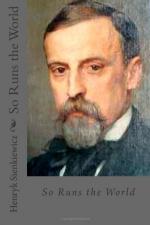If we say that the great Hungarian author Maurice Jokay, who also writes historical novels, pales when compared with that fascinating Pole who leaves far behind him the late lions in the field of romanticism, Stanley J. Weyman and Anthony Hope, we are through with that part of Sienkiewicz’s literary achievements.
In the third period Sienkiewicz is represented by two problem novels, “Without Dogma” and “Children of the Soil.”
The charm of Sienkiewicz’s psychological novels is the synthesis so seldom realized and as I have already said, the plastic beauty and abstract thoughts. He possesses also an admirable assurance of psychological analysis, a mastery in the painting of customs and characters, and the rarest and most precious faculty of animating his heroes with intense, personal life, which, though it is only an illusionary life, appears less deceitful than the real life.
In that field of novels Sienkiewicz differs greatly from Balzac, for instance, who forced himself to paint the man in his perversity or in his stupidity. According to his views life is the racing after riches. The whole of Balzac’s philosophy can be resumed in the deification of the force. All his heroes are “strong men” who disdain humanity and take advantage of it. Sienkiewicz’s psychological novels are not lacking in the ideal in his conception of life; they are active powers, forming human souls. The reader finds there, in a well-balanced proportion, good and bad ideas of life, and he represents this life as a good thing, worthy of living.
He differs also from Paul Bourget, who as a German savant counts how many microbes are in a drop of spoiled blood, who is pleased with any ferment, who does not care for healthy souls, as a doctor does not care for healthy people—and who is fond of corruption. Sienkiewicz’s analysis of life is not exclusively pathological, and we find in his novels healthy as well as sick people as in the real life. He takes colors from twilight and aurora to paint with, and by doing so he strengthens our energy, he stimulates our ability for thinking about those eternal problems, difficult to be decided, but which existed and will exist as long as humanity will exist.
He prefers green fields, the perfume of flowers, health, virtue, to Zola’s liking for crime, sickness, cadaverous putridness, and manure. He prefers l’ame humaine to la bete humaine.
He is never vulgar even when his heroes do not wear any gloves, and he has these common points with Shakespeare and Moliere, that he does not paint only certain types of humanity, taken from one certain part of the country, as it is with the majority of French writers who do not go out of their dear Paris; in Sienkiewicz’s novels one can find every kind of people, beginning with humble peasants and modest noblemen created by God, and ending with proud lords made by the kings.
In the novel “Without Dogma,” there are many keen and sharp observations, said masterly and briefly; there are many states of the soul, if not always very deep, at least written with art. And his merit in that respect is greater than of any other writers, if we take in consideration that in Poland heroic lyricism and poetical picturesqueness prevail in the literature.




